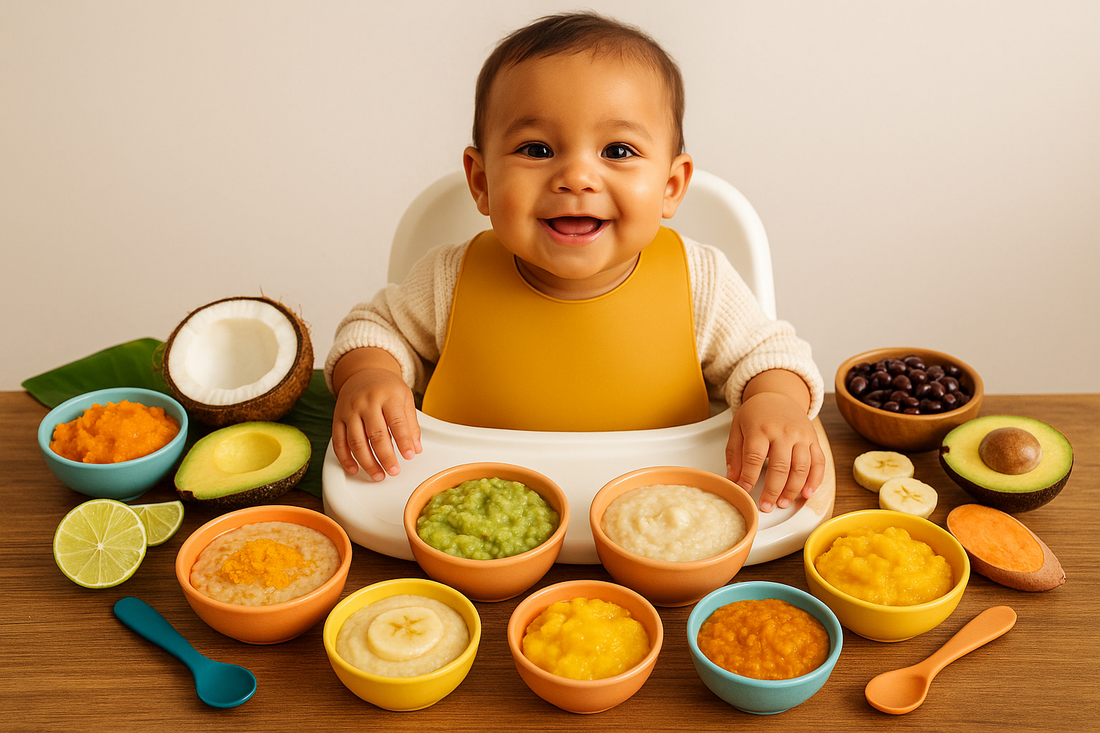
Around the World in First Bites: Why Diverse Flavors Matter for Babies
By Leanne GrantAround the World in First Bites: Why Diverse Flavors Matter for Babies
From creamy mashed yuca in the Caribbean to savory miso soups in Japan, the world is full of delicious, nutritious, and exciting flavors. At Loco Bebé, we believe introducing babies to a wide variety of global ingredients and spices early in life not only supports healthy development—but also helps build a lifelong love for good food.
Why Do Diverse Flavors Matter?
When babies are first introduced to solid foods, their taste buds are open, curious, and highly adaptable. This window of opportunity—usually starting around 6 months of age—the perfect time to expose them to a range of textures, spices, and ingredients. While plain purées like apples and carrots are a common starting point, going beyond those basics can spark curiosity, reduce food aversions, and set the stage for a more adventurous eater in the future.
Research suggests that early and repeated exposure to diverse flavors may reduce the likelihood of picky eating later on. The more babies taste, the more their brains and bodies learn to recognize (and enjoy) those foods.
Around the World in First Bites: Flavor Inspirations by Region
Let’s take a mini culinary tour around the globe for some inspiration. Here are baby-friendly flavors and ingredients from various cultures that can help expand your little one’s palate:
1. Japan: Umami-rich Miso and Nori
-
Try: Miso (in very small amounts), tofu, soft rice, or finely shredded nori (seaweed).
-
Why: Miso and seaweed introduce babies to umami, the savory "fifth taste" that many traditional baby foods lack.
2. India: Warming Spices
-
Try: Lentils (dal), turmeric, cumin, or a pinch of cinnamon or coriander.
-
Why: Indian cuisine is full of aromatic, non-spicy seasonings that support digestion and flavor recognition.
3. Mexico: Avocado & Black Beans
-
Try: Mashed avocado with lime, or puréed black beans.
-
Why: These creamy and hearty foods are packed with healthy fats and fiber—and they’re great finger foods too!
4. West Africa: Groundnuts and Leafy Greens
-
Try: Ground peanut sauce (peanut purée), soft spinach, or mashed sweet potato.
-
Why: West African cuisine includes nutrient-dense vegetables and legumes that introduce earthy flavors.
5. Mediterranean: Olive Oil & Herbs
-
Try: Mashed chickpeas (hummus), olive oil drizzled on soft veggies, or herbs like oregano and basil.
-
Why: Mediterranean foods introduce heart-healthy fats and aromatic herbs that stimulate baby’s senses.
6. The Caribbean: Tropical Fruits & Root Vegetables
-
Try: Mashed mango, mashed yuca, papaya, or coconut milk blended with rice.
-
Why: Tropical flavors are naturally sweet, helping babies transition from breast milk or formula to solids.
7. Korea: Mild Kimchi-Inspired Veggies
-
Try: Lightly fermented cabbage (washed), plain congee (rice porridge), or mashed Korean pear.
-
Why: Fermented foods in moderation can support gut health and expose babies to sour and tangy notes.
What About Picky Eating Later On?
It’s important to remember: even the most adventurous babies may become more selective as toddlers. One year they’re gobbling up quinoa and mushrooms, and the next year they only want pasta and toast. It’s all part of normal development.
That’s why continuing to offer a range of foods, even when rejected, is so important. Gentle persistence without pressure often works better than giving up on a food entirely. Exposure matters. Babies and toddlers often need 10–15 tries before they accept a new food.
Building a diverse palate is not about perfection—it’s about exploration, patience, and celebration.
Loco Bebé: Caribbean Roots, Global Flavors
At Loco Bebé, our organic baby food is inspired by our roots in the Dominican Republic, where tropical fruits, vibrant spices, and real food culture shape everything we do. Our goal is to make organic baby food exciting and flavorful—not bland or boring. We incorporate ingredients like mango, lime, banana, pineapple, and coconut to create adventurous blends that babies love.
Our flavors are designed to honor the diversity of food cultures while helping families create positive, playful food moments at home or on the go.
Final Thoughts
Food is more than just fuel—it’s identity, culture, joy, and connection. Introducing your baby to a range of global flavors helps them not only enjoy food but understand and appreciate diversity from the very beginning.
So go ahead—blend in that turmeric, mash those black beans, and spoon out the mango-lime purée. You’re not just feeding your baby; you’re giving them the world.
Disclaimer: This blog reflects personal opinion and general information. Every child is different. Please consult your pediatrician or family doctor before introducing new ingredients to your baby’s diet, especially allergens or fermented foods.